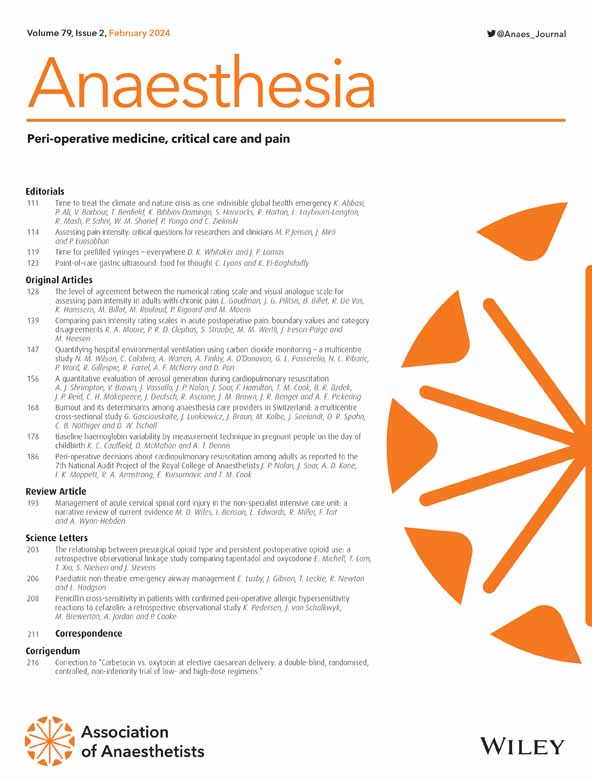41个国家挥发性麻醉剂温室气体排放趋势:2013-2023年。
IF 6.9
1区 医学
Q1 ANESTHESIOLOGY
引用次数: 0
摘要
吸入麻醉剂会导致温室气体排放,导致一些国家对其进行管制限制。这项研究分析了41个国家使用挥发性麻醉剂直接导致的温室气体排放的时间趋势。方法销售数据采用IQVIA MIDAS®和国家药品监管机构的数据。我们计算了2018年至2023年挥发性麻醉剂排放的人均二氧化碳当量千克数(基于全球变暖潜势)和温室气体排放的百分比变化。结果获得了41个国家的数据,约占全球人口的35%。研究中包括的27个欧盟国家和其他“西方”国家(澳大利亚、加拿大、新西兰、英国和美国)与挥发性麻醉剂相关的温室气体排放量有所下降,在某些情况下,人均二氧化碳当量低于0.5公斤。相比之下,一些亚洲国家的排放量大幅增加,韩国和日本报告的排放量在全球最高(人均约2.5公斤二氧化碳当量)。一项仅限于欧洲国家的二次分析显示,最高排放国和最低排放国的人均碳当量排放量相差17倍,这表明有关使用挥发性麻醉剂的建议的执行不一致。我们的研究强调了由于使用挥发性麻醉剂导致的温室气体排放管理的巨大差异。虽然结果显示西方国家呈下降趋势,尽管差异很大,但在许多亚洲国家观察到的上升趋势可能令人担忧。逐步淘汰影响最大的挥发性麻醉药的国家的经验表明,将人均二氧化碳当量减少到0.5公斤以下是可以实现的。这应成为其他制度的典范,促进教育倡议和具体政策的执行。本文章由计算机程序翻译,如有差异,请以英文原文为准。
Trends in greenhouse gas emissions from volatile anaesthetics in 41 countries: 2013-2023.
INTRODUCTION
Inhalational anaesthetics contribute to greenhouse gas emissions, leading to regulatory restrictions in some countries. This study analysed time trends of greenhouse gas emissions directly attributable to the use of volatile anaesthetic agents in 41 countries.
METHODS
Sales data were obtained using data from IQVIA MIDAS® and national medicines agencies. We calculated the kilograms of carbon dioxide equivalents (based on global warming potential) per capita and percentage change in greenhouse gas emissions, from the emission of volatile anaesthetics from 2018 to 2023.
RESULTS
Data were obtained for 41 countries, representing approximately 35% of the global population. Greenhouse gas emissions associated with volatile anaesthetic agents decreased in the 27 European Union nations and other 'western' countries included in the study (Australia, Canada, New Zealand, UK and USA), achieving in some cases below 0.5 kg of carbon dioxide equivalents per inhabitant. In contrast, several Asian countries showed a substantial increase in emissions, with South Korea and Japan reporting the highest values globally (approximately 2.5 kg of carbon dioxide equivalents per inhabitant). A secondary analysis restricted to European countries showed a 17-fold difference in per-capita carbon-equivalent emissions between the highest and lowest emitters, suggesting that recommendations on the use of volatile anaesthetic agents are implemented inconsistently.
DISCUSSION
Our study highlighted large differences in the management of greenhouse gas emissions attributable to volatile anaesthetic use. While results show a decreasing trend in western countries, albeit with substantial variation, rising trends observed in many Asian countries may constitute a source of concern. The experience of nations that have phased out the highest impacting volatile anaesthetic agents show that reducing emissions below 0.5 kg of carbon dioxide equivalents per inhabitant is attainable. This should serve as a model for other systems, prompting implementation of educational initiatives and specific policies.
求助全文
通过发布文献求助,成功后即可免费获取论文全文。
去求助
来源期刊

Anaesthesia
医学-麻醉学
CiteScore
21.20
自引率
9.30%
发文量
300
审稿时长
6 months
期刊介绍:
The official journal of the Association of Anaesthetists is Anaesthesia. It is a comprehensive international publication that covers a wide range of topics. The journal focuses on general and regional anaesthesia, as well as intensive care and pain therapy. It includes original articles that have undergone peer review, covering all aspects of these fields, including research on equipment.
 求助内容:
求助内容: 应助结果提醒方式:
应助结果提醒方式:


